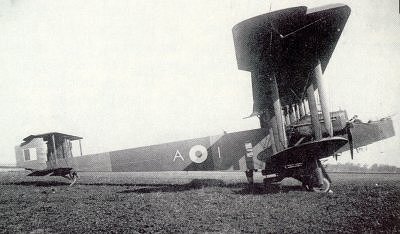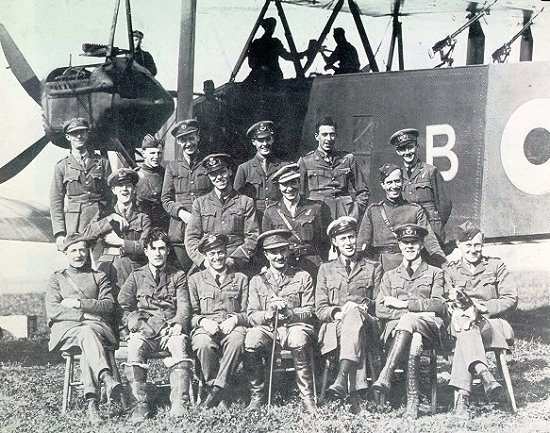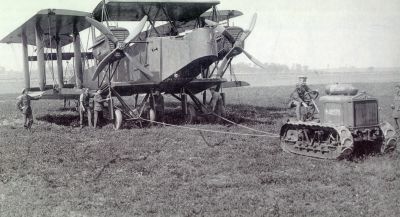207 SQUADRON ROYAL AIR FORCE HISTORY
WORLD WAR I
1918
In June 1918 the Air Ministry's plans for a true
strategic bombing force for the RAF finally bore fruit with
the official creation of the Independent Force, RAF on 6
June, commanded by Maj-Gen Sir Hugh Trenchard KCB DSO.
Although the principle for such a force had been manifested
originally with the formation of Capt Elder's No. 3 Wing,
RNAS in 1916-17, the contemporary needs of the RFC had
resulted in the Wing's disbandment, and it was primarily as a
result of a public outcry in Britain for retaliation for
German aerial attacks on England in 1917 that the decision
was made to institute a bombing offensive against industrial
objectives within Germany.
At the moment of its inauguration the Independent Force had
merely one Handley Page unit on strength, No.216 Sqn based at
Ochey, but on 7 June 1918 a second HP unit, No.207 Sqn,
freshly equipped with 10 HP O/400s in England and commanded
by Maj G L Thomson DSC, arrived at Ligescourt, from where it
recommenced operations under the control of the 54th Wing, IX
Brigade RAF.
Considering how much importance - and relative urgency - was
given to the creation of the Independent Force, it may seem
illogical that 207 Sqn was not included immediately in that
force, yet the fact remains that 207 operated under the aegis
of other RAF formations for the rest of the war.
The squadron's
aircraft in June 1918 included HP O/400s:
|
 This HP O/400 (A 1) of 207 Sqn flew from Andover to Ligescourt near Abbeville: note 1650lb bomb attached between undercarriage legs |
The first night attack by the new 207 Squadron took place on 22 June 1918 against Bapaume. Between this date and the end of the month, the Squadron dropped no fewer than 40 tons of bombs.
Among its own replacements 207 Sqn received HP O/100 1460, a veteran aircraft which had achieved the distinction of being the very first Handley Page 'heavy' to fly on operations in March 1917 with No. 3 Wing RNAS. Its stay with 207, however, was short. On the night of 18/19 July, 1918, it was hit by flak during a raid and forced to land at Saizerais, where it was classified as damaged beyond repair.
On the same night a second HP from 207, C9665, failed to return and its crew, Lts F Kemp, W M F Bayliss and G Rose were later reported as prisoners of war.
On 26 July, Major G L Thompson was replaced as Squadron Commander by Major T A Batchelor who was himself replaced when injured in a flying accident. The new commander was Major G R Elliot.

Officers of No.207 Squadron Royal Air Force, Ligescourt 29
Aug 1918 in front of a B Flight HP O/400: centre is Major G R
Elliott, arrived as CO 8 Aug 1918: back: 2nd Lts Garratt,
Stockdale, Wiltshire, Paton, Tremain, Hamilton: middle: Lts
Semple, Reed: 2nd Lts Tweedie, Moth: front: Lts Cade,
Pearson: Capt Millson, Maj Elliott: Lts Johnson, Roy, Harvey:
mascots: Nigger the cat and Carpenter the
dog: identifications by Clive
Semple (son of Lt Semple).
Throughout the victories which were won during the last three months of the war, No.207 Squadron carried out an unremitting series of attacks against major enemy camps such as Peronne, Cambrai and Valenciennes. In August alone they dropped over 100 tons of bombs despite bad ground mists. Eighty tons of this total was deposited on one target, Peronne railway station, during six successive nights.
On 8th August 1918 an Allied ground offensive - the battle of Amiens - was due to start, with tank support. The previous night the RAF was detailed to provide aircraft to fly over the adjacent tank assembly areas and nearby no-man's land in order that their engines could drown out the noise of the tanks' engines and thereby provide a cloak of secrecy as to the armoured ground formations' presence.
One Handley Page pilot of No.207 Sqn, Lt Gordon A Flavelle, was skipper of one of the many aircraft to be involved in this one-off type of operation. Weather on the evening prior to the offensive would normally have been considered 'dud' in the RAF vernacular, but the importance of their task led to all crews involved attempting to carry out their orders. At 10pm on 7 August the first attempts were made, but with the cloud base at a mere 300ft and driving rain obliterating visibility, all aircraft were forced to return to base. At midnight a second attempt was made under seemingly impossible flying conditions and all machines were lost to sight when only 50 feet off the ground. At 0021 hrs one HP returned to report that the crew had been unable to see the ground the whole time they were airborne and the pilot had practically no positive control of the aircraft.
Gordon Flavelle, however, forged his way up through the dense clouds and pelting rain, relying wholly upon his few instruments for control of the aircraft, until finally breaking out of the lower cloud layer and rain. Flying then on a compass course and by adjudged timing, Flavelle reached his allotted section of the sky to 'patrol' and for nearly three hours thereafter steadily flew back and forth in the face of unceasing strong, gusting winds and constant heavy rain. On eventual return to base, having been airborne for three and a half hours in incessantly atrocious weather, Flavelle was in such a state of exhaustion that he could hardly stand upright and had to be physically assisted to his tent. Flavelle's outstanding devotion to duty was noted and his name forwarded for a gallantry decoration. This - a DFC - was gazetted on 2 November, 1918, and its citation included the words: 'The spirit of this officer in the face of the most impossible conditions, and carrying out his orders to the letter, set a splendid example to the squadron and showed remarkable devotion to duty.'
The HP crews, though always gaining satisfaction from successful raids on factories, blast furnaces and the like, regarded their many raids on enemy airfields particularly satisfying. It fell to 207 Sqn to open the Handley Pages' 'account' for September 1918, when five HPs raided Marquion town and rail station on the 1st/2nd of the month. The last aircraft to attack was carrying 12 x 112lb bombs, but also 1080 Baby Incendiaries (BIs) in small containers. Making its initial run-in to the target at 4500 ft at 0235 hrs, all the 112lb bombs were seen to burst in a line across the town, but only a few BI cans were released, due to defective release gear.
On the return journey, to the crew's dismay, several more BI cans dropped away of their own accord, landing in some open fields between the Allied 'D' and 'W' lighthouses. With more BIs still hung up in the bomb bay, the pilot made out to sea, circling round the mouth of the Somme River for 30 minutes and trying to jettison the reluctant BI cans. Only one can was finally shaken off and fell into the sea, but three more refused to leave their racks.
Returning to his airfield, the pilot duly landed cautiously - and two BI cans promptly released and proceeded to burn fiercely right underneath the aircraft! As the pilot reported succinctly: 'These bombs are evidently very unreliable and unsafe to carry...' These BI incendiary bombs, each weighing 6½ oz, were usually packed 272 to a special 'can' (container) and when released scattered much like a cluster bomb of later years in RAF use, but in the incident described here armourers on 207 Sqn were not completely familiar with the devices and a specially trained armament mechanic had to be sent from England to instruct them before any further BI loads were carried.
But September 1918 saw the Squadron short of pilots. Those who remained worked so hard to maintain the Squadron effort that almost as many bombs were dropped as in August.
In the early hours of 15th September, C9683 from 207 Sqn (Lts A Tapping/W J N Chalklin/2/Lt J B Richardson) failed to return from operations. The following evening No.207 Squadron could only muster five pilots due to several others being victims of an influenza epidemic which was affecting all units in mid-September. Nevertheless, the five pilots flew a total of nine raids during the night of the 15/16th, attacking Etreux airfield and dropping in all two 1650lb SN, 190 x 112lb and 73 x 25lb bombs - an outstanding effort which lasted from mid-evening on the 15th until the last HP returned at 0330 hrs next morning, delivering over seven and three quarter tons of bombs to the extreme discomfort of the enemy.
On 16/17 September, No.207 Sqn contributed five machines to the night's operations, again attacking Etreux airfield, with one 1650lb SN, 63 x 112lb and 40 x 25lb bombs with visible success; all five aircraft returned safely.
For the next three nights weather conditions cancelled nearly all HP operations, although 207 Sqn mounted a raid by five machines against Tupigny airfield, dropping one 1650lb SN and 62 x 112lb and 40 x25 lb bombs on 17/18 September.
With the return of reasonable weather conditions the HP squadrons resumed operations in some force on the night of 20/21 September. 207's contribution was an attack on Thourout railway station, with three machines making two trips in the night. Adverse weather prevented the five Independent Force HP squadrons from operating on the next three nights but not the other three HP squadrons. On 22/23 September 207 Sqn provided eight aircraft for raids on Saultain airfield and rail rargets at Valenciennes and in the Douai area. One machine aborted its sortie with engine troubles and a second returned early due to high winds impeding progress, but four attacked Saultain, dropping one 1650lb SN, 32 x 122lb and 25 x 25lb bombs, destroying five hangars and a large three-bay shed. A second 1650lb SN was dropped on a railway line north of Valenciennes while the remaining HP dropped its normal load of 112lb bombs on another railway line near Douai.
Bad weather again prevented the Independent Force HPs from operating at night on 27-29th September but the other three HP squadrons kept busy: 207 Sqn attacked Busigny rail centre with seven HPs on the 27th/28th.

A 207 HP O/400 (B 1, wings folded) on tow
by a Clayton tractor 48578